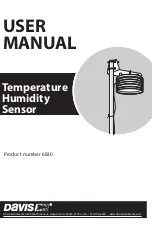
Sequence of operation
VAV Zone II Controllers
CARRIER CORPORATION ©2019
Installation and Start-up Guide
All rights reserved
54
Indoor Air Quality Alarm
– If
Optional Ctrl Type
is set to
IAQ Control
(CO
2
sensor is installed), the controller
generates an alarm during occupied periods if the sensor's value exceeds the
Occupied High CO2 Alarm Limit
.
When a transition from unoccupied to occupied occurs, or if the occupied alarm limit is changed to a value that
causes an alarm condition to occur, the controller automatically calculates an alarm delay equal to 15 seconds for
each ppm of change based on the error from setpoint (15 minutes minimum, 4 hours maximum). This delay
prevents unnecessary alarms and gives the zone time to correct the alarm condition. To disable the IAQ alarm, set
Occupied High CO2 Alarm Limit
to 0. The default value is 1100ppm. The hysteresis for return to normal is
100ppm.
Filter Alarm
– For series or parallel fan-powered terminals, the controller monitors the accumulated hours of fan
operation and generates an alarm when accumulated hours exceed the configured
Filter Service Alarm Timer
limit. The default value is 0 hours which disables the alarm. The alarm can be reset by setting
Reset Filter Alarm
to On or resetting the configured alarm limit to 0 hours.
Airside Linkage Alarm
– The slave zone controller generates an alarm if it has once been linked successfully to a
master zone and then it fails to receive linkage information for 5 minutes. If the controller is the VVT Master, it
generates an alarm if it does not communicate with its air source for 5 minutes after having been previously
communicating successfully. A return-to-normal is generated after successful Linkage communication resumes. A
power cycle will reset and re-initialize the
Airside Linkage Alarm
.
The ZS Pro with display has alarm and maintenance indicators. See
Alarm Configuration
(page 80).
Demand limiting
Demand limiting is a cost-saving strategy to reduce energy consumption. The strategy expands the setpoints when
the system reaches one of 3 levels of consumption. With the expanded setpoints, the equipment works less,
thereby saving energy.
If the VAV Zone II receives a demand limit signal through the network, it expands its setpoints based on the
demand level. The default amounts are:
Demand Level 1: 1 °F (.6 °C)
Demand Level 2: 2 °F (1.1 °C)
Demand Level 3: 4 °F (2.2 °C)
Linkage
The i-Vu® Control System uses linkage to exchange data between the zone terminals and their air source to form
a coordinated HVAC system. The system's air source controller, zone controllers, and bypass controller (if
applicable) are linked so that their data exchange can be managed by one zone controller configured as the
Master.
The basic linkage process is as follows:
Содержание VAV Zone II
Страница 109: ......
















































